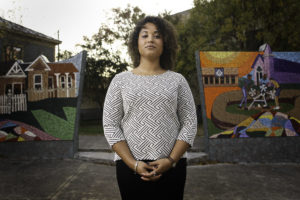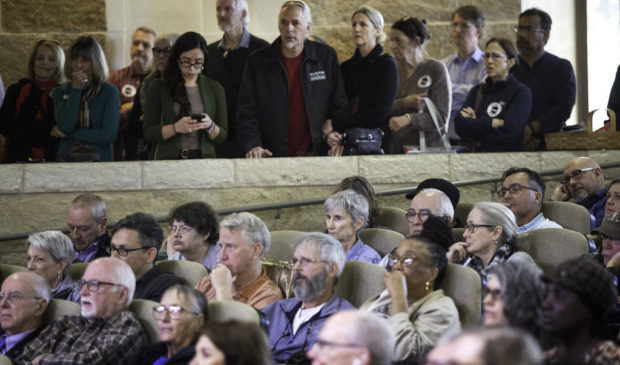White homeowners dominate input over Austin’s land code rewrite. One group is trying to change that.
Monday, December 9, 2019 by
Audrey McGlinchy, KUT More than 100 people sat in Austin City Hall chambers just past 10 a.m. on Saturday, gearing up to share their thoughts about the city’s rewrite of its Land Development Code. Council Member Alison Alter, who represents part of Northwest Austin, took a photo from her seat on the dais and posted it to Twitter, writing, “This is what democracy looks like.”
Then the pushback began. The majority of people who responded to her tweet pointed out that the crowd looked white and older than the rest of Austin.
Alter defended her tweet by text Sunday, saying, “Over 500 people from all over the city came yesterday to share their views.”
Those who criticized Alter weren’t wrong. According to data collected by KUT at Saturday’s public hearing – one of the most well-attended in the city’s six-year-plus journey to rewrite its building rules – 77 percent of those who spoke identified as white, and 69 percent as white homeowners. That’s in a city where less than half the population is white and more than half of residents rent.
This was no surprise to Isabelle Atkinson, who works for an affordable housing finance company.

Isabelle Atkinson, who works for an affordable housing finance company, helped form Planning Our Communities, a group of young activists hoping to diversify the conversation around Austin’s development and growth.
CREDIT JULIA REIHS / KUT
“Those spaces are primarily white,” she said, referring to conversations about city planning and housing. Atkinson, 27, said she and other people of color who work in housing began to notice each other over the past year.
“We’d come across each other at different events and notice that we were the only other young people of color in the room,” she said, “and slowly we built this group.”
The group, Planning Our Communities or POC, is hoping to diversify the land code conversation – both when it comes to who’s weighing in and what they’re saying.
Members of the group testified publicly for the first time in favor of the code rewrite Saturday.
“There’s a comfort in being vocal about what we want the city to look like,” Atkinson, who could not attend, said. “But unfortunately, our voices are often left out of that conversation.”
Who Shows Up
Those who spoke at City Hall on Saturday were overwhelmingly white and owned their own homes. Their median age was 51. (See “A Note on the Data” at the end of this story for information on how KUT collected this data, including caveats.)
A Boston University study of people who participated in planning and zoning meetings in and around Boston between 2015 and 2017 found that overall, participants in these community meetings were “older and more likely to be white, male and own a home.”
And those who do show up to the meetings tend to oppose rezoning.
“What are we afraid of? Good lord,” said Nick van Bavel, a Hyde Park homeowner who testified Saturday. “We are afraid that this new code is going to destroy our neighborhood. It is going to irrevocably change our neighborhood.”
Of the people who spoke against the new land code rewrite, 92 percent said they own their homes. (A small number of renters testified – 28 out of 134 speakers by KUT’s count. This is in a city where more than half of residents rent.
The median age of registered voters in Austin is 37, but the median age of those who spoke was nearly 15 years older. And those speaking against the proposed new code were even older.
While most Council members stayed silent Saturday to get through the hundreds of speakers who signed up to testify, Council Member Natasha Harper-Madison, who represents East Austin, took a moment to thank a 23-year-old student for coming.
“If you’ll look around the room, you’ll see that you’re one of the only folks of your generation here,” she told him. “It’s really important that everybody participate in the system, so I really appreciate you coming out.”
The lack of participation by younger, more diverse residents is not a new problem in the city’s process of rewriting the Land Development Code. Language, work, child care and transportation barriers make it difficult for people to come to City Hall and speak. The comments online also have come from people living in wealthier neighborhoods. While CodeNEXT was being debated in 2017, KUT found that the majority of online comments were coming from Central Austin neighborhoods rather than neighborhoods in East Austin.
Whether you’re for or against the proposed new code – a divide often framed as NIMBY vs. YIMBY, or “Not in my backyard” versus “Yes, in my backyard” – those opposing denser housing and those loudly cheering it Saturday were, again, overwhelmingly white homeowners.
Ushering In Change
Nearly three hours into Saturday’s hearing, a group from Planning Our Communities gathered around the microphone to testify. Of the members of the group who spoke, all but one said they own a home. Their median age was 32.
“We’ve long known Austin is set to grow,” Sarah Rodriguez, who testified alongside POC members, told Council. “What has been surprising is the amount of time it’s taken to admit that and be willing to work on that.”
In the months leading up to the city’s release of the latest revision of its land use code in October, familiar faces in Austin’s housing conversation reemerged. Groups like Community Not Commodity warned residents the new code could raise their property taxes and lead to the demolition of single-family homes. Members of AURA began renewed calls for more housing, especially “missing-middle” housing.
Then a new voice entered the scene.
“On one hand, I’m not a NIMBY, on the other hand I’m not an urbanist,” Chas Moore, who founded the Austin Justice Coalition, said when Planning Our Communities announced its formation in late September. “The answer isn’t build everything everywhere, and the answer isn’t build nothing.”
POC pegs itself as “anti-displacement, but not anti-developer” and is made up of people of color, many of whom work in affordable housing. Members say they have the professional experience of knowing how housing gets built and how it can be affordable, and the personal experience of being people of color.
“We could maybe help usher in a little bit of change in terms of how these conversations are going,” Atkinson said.
POC is asking the city to build more housing, but to be mindful of where it goes. It says the city should rezone parts of West Austin, where development typically has been stalled, to allow for more housing instead of continuing to focus new housing in East Austin.
“We want to honor the work and the emotions and the connections that folks have to the land, but how do we also, with this booming growth for various reasons, create the capacity for affordability?” said POC member Shavone Otero, a program manager with HousingWorks.
The group’s work has caught the ears of some City Council members. Last month, Mayor Pro Tem Delia Garza, who represents Southeast Austin, suggested the city scale back allowing for more market-rate housing in parts of the city that may soon begin gentrifying, while also finding ways to encourage developers to build low-income housing. It was an idea proposed by the Austin Justice Coalition, which has been working with Planning Our Communities.
“In so many ways (POC is) a home for younger activists, younger people of color and people that care about equitable development,” Council Member Greg Casar said at POC’s launch in September. “So many of the folks standing behind me have been doing this work actually for a very long time, but so often get ignored or left out of the traditional narrative of housing policy and transit policy in our city.”
Members of POC are careful to acknowledge that people of color have been organizing around the land code rewrite for some time. This includes groups like Go Austin! Vamos Austin!, which organizes people living in heavily Hispanic neighborhoods in Southeast Austin. It aired a 16-minute video Saturday, featuring low-income homeowners and renters who oppose the land code rewrite.
Atkinson said she was frustrated to learn the majority of voices were white homeowners who opposed the proposal – many from districts 9, 10 and 7, which cover much of Central and Northwest Austin. She said she hopes when Council takes an initial vote on the code this week, members relinquish ward politics and consider the needs of the entire city.
“They’re also representing the city as a whole, and I think that’s something that can get lost if you’re only listening to the constituents in your district or the people that show up,” she said. “We can’t continue acting as this hodgepodge group of collective neighborhoods. We are one city. We are a city.”
*A Note on the Data
KUT’s Audrey McGlinchy talked to 134 speakers at Saturday’s hearing. This was a majority of speakers over a seven-hour period; she missed roughly 1.5 hours of testimony. McGlinchy approached each person who spoke, asking them to identify their race, age and whether they own their home or rent. Only three people refused to answer any questions.
A video was played at the beginning of testimony, featuring low-income renters and homeowners. McGlinchy spoke with the organizer and worked to represent these speakers in the data.
Several people did not want to provide their exact ages, so their age was recorded as the first in that decade. For example, someone who said she was in her 60s was recorded as 60. Therefore, the age data may run a bit younger. A couple of people’s living situations fell outside the renter/owner dichotomy. One man who said he lived in a co-op was recorded as a renter. A woman who said she lived with her parents was recorded as neither renting nor owning
Correction: An earlier version of this post stated 78% of the people who spoke against the new land code rewrite said they owned their homes. It was actually 92%.
.
This story was produced as part of the Austin Monitor’s reporting partnership with KUT. Photo by Julia Reihs.
The Austin Monitor’s work is made possible by donations from the community. Though our reporting covers donors from time to time, we are careful to keep business and editorial efforts separate while maintaining transparency. A complete list of donors is available here, and our code of ethics is explained here.
You're a community leader
And we’re honored you look to us for serious, in-depth news. You know a strong community needs local and dedicated watchdog reporting. We’re here for you and that won’t change. Now will you take the powerful next step and support our nonprofit news organization?











